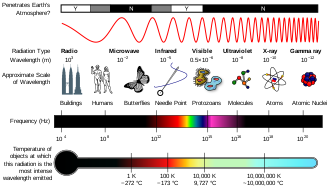| nanometre | |
|---|---|
 One nanometric carbon nanotube, photographed with scanning tunnelling microscope | |
| General information | |
| Unit system | SI |
| Unit of | length |
| Symbol | nm |
| Conversions | |
| 1 nm in ... | ... is equal to ... |
| SI units | 1×10−9 m 1×103 pm |
| Natural units | 6.1877×1025 ℓP 18.897 a0 |
| imperial/US units | 3.9370×10−8 in |

The nanometre (international spelling as used by the International Bureau of Weights and Measures; SI symbol: nm), or nanometer (American spelling), is a unit of length in the International System of Units (SI), equal to one billionth (short scale) or one thousand million (long scale) of a metre (0.000000001 m) and to 1000 picometres. One nanometre can be expressed in scientific notation as 1 × 10−9 m and as 1/1000000000 m.